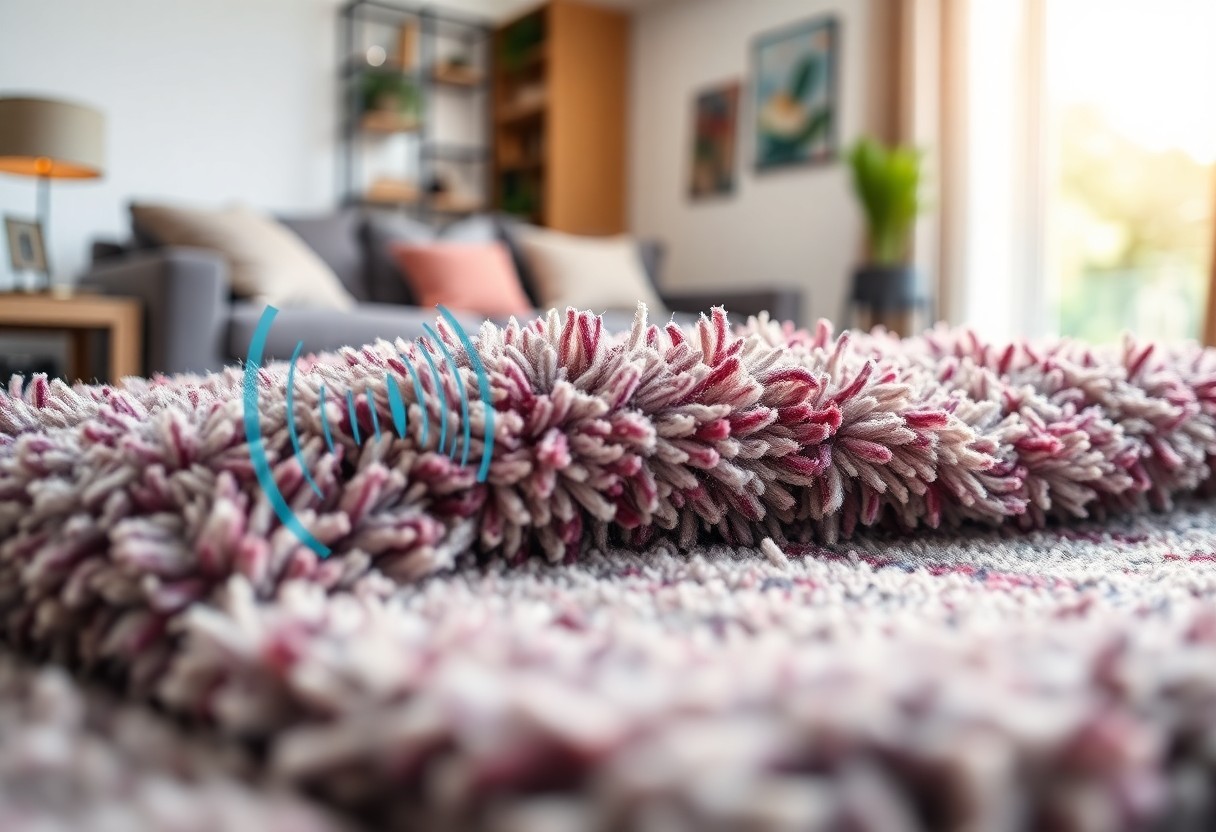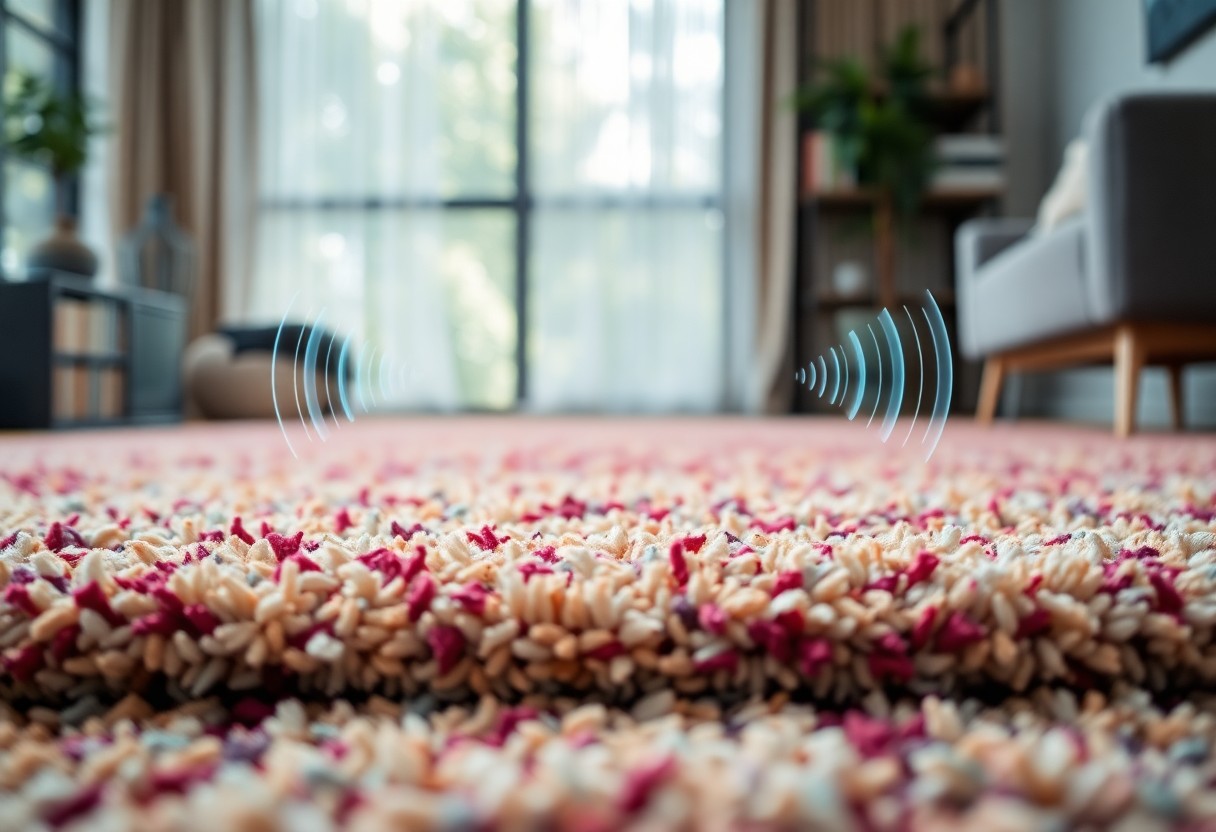Over the years, you may have noticed how the ambience of a room can significantly affect your comfort. Carpets play a vital role in enhancing the acoustic serenity of your space by absorbing sound and reducing echo, making your environment feel more tranquil. They help to muffle footstep noise and minimise distractions from outside, creating a peaceful atmosphere for both relaxation and productivity. By understanding the impact of carpets on sound dynamics, you can make informed decisions about your flooring choices to improve the overall serenity of your rooms.

Key Takeaways:
- Carpets absorb sound, reducing noise levels by preventing echo and reverberation in a room.
- They enhance the overall acoustic comfort by dampening footsteps and other impactful sounds, creating a more serene environment.
- Caring for carpets, such as regular cleaning and appropriate underlay, ensures their sound-absorbing qualities are maintained over time.

Understanding Acoustic Serenity
To achieve a tranquil environment, it’s important to consider how various elements within your space contribute to acoustic serenity. Carpets can significantly enhance this aspect by absorbing sound and reducing noise levels. For further insights, explore Creating Serenity: Exploring the Benefits of a Soundproof Carpet.
Definition of Acoustic Serenity
Acoustic serenity refers to the pleasant auditory environment achieved by minimising unwanted noise and enhancing sound quality in a room. This balance creates a peaceful atmosphere, conducive to relaxation and focus.
Importance in Interior Design
By incorporating sound-absorbing materials like carpets, you can significantly improve the acoustic qualities of your interiors. This not only elevates the comfort level but also enhances the overall aesthetic of your space.
For instance, when designing a living area, choosing a thick, plush carpet can diminish echoes and background noise, creating a more inviting atmosphere. This attention to detail not only enhances acoustic comfort but also showcases your style, offering a harmonious blend of functionality and design. Ultimately, a well-designed acoustic environment can elevate your overall experience within the space.
The Role of Carpets in Sound Absorption
If you are seeking to enhance the acoustic quality of your living space, carpets play a significant role in sound absorption. By reducing noise levels, they create a more serene environment, helping to dampen echoes and minimise background noise, allowing you to enjoy a quieter, more peaceful atmosphere in your home.
Materials and Their Acoustic Properties
On choosing the right carpet material, it’s important to consider how different fibres impact sound absorption. Natural fibres such as wool and cotton typically provide better acoustic properties compared to synthetic options like nylon or polyester, making them ideal choices for creating a quieter space.
Thickness and Pile Height
Across various carpet options, thickness and pile height significantly influence sound absorption capabilities. Thicker carpets or those with a higher pile tend to trap more sound, further contributing to a reduction in noise levels within your room.
This means that when selecting your carpet, opting for a thicker style can provide superior sound insulation. Carpets with a higher pile height are better at absorbing impact noise, which is particularly beneficial in multi-storey homes or apartments. By considering both thickness and pile height, you can enhance your room’s acoustic serenity, allowing for a quieter and more comfortable living environment.
Carpets vs. Hard Surfaces
Keep in mind that the type of flooring you choose can significantly influence the acoustic qualities of your room. Carpets are renowned for their sound-absorbing properties, while hard surfaces, like wood or tile, tend to reflect sound, creating a noisier environment. By understanding these differences, you can make an informed decision that enhances your space’s tranquillity.
Comparative Sound Reflection
Beside carpets, hard surfaces vary considerably in how they reflect sound. Here’s a brief comparison:
| Flooring Type | Sound Reflection |
|---|---|
| Carpet | Absorbs sound, reducing echoes |
| Wood | Moderate reflection, can create a hollow sound |
| Tile | High reflection, often leads to noisy environments |
Impact on Room Ambiance
Beside their acoustic benefits, carpets significantly influence the overall ambience of your room. They contribute warmth and comfort, making your space feel more inviting and serene.
Even when considering aesthetics, carpets play a pivotal role. Their textures and colours can create a sense of cohesion and warmth that hard surfaces often lack. By softening the sound environment and enhancing visual appeal, carpets can transform an ordinary room into a sanctuary, allowing you to enjoy peace and tranquillity within your home.
Strategic Carpet Placement
For achieving optimal acoustic serenity, strategic carpet placement in your room can have a profound impact. By positioning carpets in key areas, such as under furniture or in high-traffic zones, you can significantly reduce noise levels while enhancing the overall aesthetic of the space. Ensure that your carpets extend beyond just the centre of the room, as this helps absorb sound waves that would otherwise bounce off hard surfaces, contributing to a more tranquil environment.
Best Practices for Optimal Effect
Carpet selection is important when aiming for maximum acoustic benefit. Opt for thick, plush carpets with dense fibres to effectively absorb sound. Consider layering carpets, particularly in larger rooms, as this can further dampen noise. Additionally, placing area rugs in specific locations can help control sound in targeted areas, particularly in open-plan spaces where reverberation might be an issue.
Room Layout Considerations
Beside the type of carpet, how you arrange your furniture also plays a significant role in your room’s acoustics. Position larger items, such as sofas or bookcases, against walls, which can help absorb sound and prevent it from travelling. Consider creating zones within your space; having carpets in each zone can help segment the room and enhance sound absorption, contributing to a more serene atmosphere overall.
Understanding the dynamics of your room layout is imperative for optimising acoustic performance. Elements like ceiling height, wall finishes, and the existing furniture can influence sound behaviour. An open layout may benefit from strategically placed carpets that create distinct areas, while a more enclosed space can take advantage of wall-to-wall coverage. By thoughtfully considering these factors, you can ensure your carpet placement works harmoniously with your overall design to enhance sound quality.
Maintenance and Longevity of Acoustic Carpets
Once again, the maintenance of your acoustic carpets plays a pivotal role in ensuring their longevity and effectiveness. Regular cleaning and care not only enhance their appearance but also preserve their sound-dampening properties. By adhering to proper maintenance routines, you can prolong the lifespan of your carpets, allowing them to continue providing the serene environment you desire.
Cleaning Techniques
Against dust and dirt build-up, it is imperative to employ effective cleaning techniques for your acoustic carpets. Vacuuming regularly and using a suitable carpet cleaner will keep your carpets looking pristine while maintaining their acoustic qualities. Always refer to the manufacturer’s guidelines for the best products and methods to ensure your carpets remain in top condition.
Durability and Performance
At the heart of acoustic carpets is their ability to withstand wear and tear while continuing to perform effectively. The materials used in these carpets are designed to resist damage and maintain their sound-absorbing qualities over time. Investing in high-quality acoustic carpets ensures you benefit from enhanced durability without sacrificing aesthetics or performance.
Considering that you want your acoustic carpet to perform optimally, selecting one made from durable materials can significantly impact its longevity. Look for products that are specifically designed for heavy foot traffic and feature stain-resistant properties. By doing so, you can ensure consistent performance in noise reduction and sustainability—allowing your carpets to remain an effective component of your room’s serenity for years to come.
Case Studies: Carpets in Different Spaces
Now, let’s explore various case studies that illustrate the impact of carpets on acoustic serenity:
- 1. Residential Lounge: Reduced noise levels by up to 30% in homes with wall-to-wall carpeting.
- 2. Home Theatre: Soft fibres absorb sound, enhancing audio clarity by 25% in dedicated cinema rooms.
- 3. Office Space: Carpet tiles decreased echo by 40%, leading to fewer distractions during meetings.
- 4. Hotel Lobbies: Plush carpets improved guest satisfaction ratings by 15% due to a quieter atmosphere.
- 5. Classrooms: Installation of carpets resulted in a 20% improvement in student focus as background noise was minimised.
Residential Settings
About carpets in residential settings, they serve not just as decorative elements, but also as sound buffers. In living rooms and bedrooms, carpets can significantly diminish noise transmission, providing a more tranquil environment. They absorb footfall sounds and reduce overall reverberation, making your home feel more inviting and serene.
Commercial Environments
The effect of carpets in commercial environments cannot be understated. They play a vital role in creating a pleasant atmosphere by reducing noise levels, thereby enhancing focus and productivity within the workspace.
At the heart of any successful commercial space is the need for a conducive working environment. By installing carpets, offices can lower sound levels from conversations and equipment, fostering an atmosphere where employees can concentrate better. Whether in open-plan offices or quieter meeting rooms, carpets absorb sound, greatly reducing distractions and creating a more harmonious workplace. This ultimately leads to improved comfort and satisfaction for both employees and clients alike.
Summing up
Considering all points, you will find that carpets play a significant role in enhancing the acoustic serenity of your room. By absorbing sound waves and reducing echo, they create a more tranquil environment, ideal for relaxation or focused work. This soft flooring option not only dampens noise from both within and outside your space but also adds warmth and comfort underfoot. Therefore, investing in quality carpets can greatly improve the overall ambience of your home.
FAQ
Q: How do carpets absorb sound in a room?
A: Carpets are designed with fibrous materials that naturally absorb sound waves. The dense pile of the carpet traps sound vibrations, preventing them from bouncing off hard surfaces like walls and ceilings. This absorption reduces echo and overall noise levels, creating a more serene environment. Additionally, the thicker the carpet, the better the sound absorption, making it an effective choice for reducing unwanted noise in any space.
Q: What types of carpets are best for enhancing acoustic comfort?
A: Generally, carpets with a high pile and dense fibres are preferable for enhancing acoustic comfort. Plush carpets, such as those made from wool or a synthetic blend, are particularly effective as they provide ample cushioning to absorb sounds. Furthermore, carpets with a thick underlay contribute even more to sound insulation by adding an extra layer of sound-dampening material beneath, thus enhancing the overall acoustic quality of the room.
Q: Can carpets help reduce noise between floors in multi-storey buildings?
A: Yes, carpets can significantly reduce noise transmission between floors in multi-storey buildings. They act as a barrier, absorbing sound from footsteps and other impactful noises. This is particularly beneficial in residential buildings, where sound transfer between flats can cause disturbances. To optimise this effect, it’s advisable to use thicker carpets with substantial underlay, as this combination will cushion against impacts and minimise sound transfer to lower levels.

